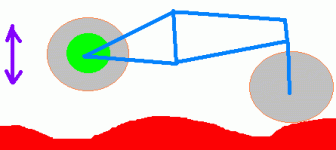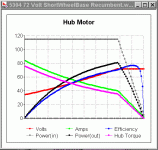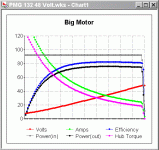safe
1 GW
- Joined
- Dec 22, 2006
- Messages
- 5,681
xyster said:Takes me about 10 seconds to reach the 28mph point of 80% hubmotor efficiency. That's very little time out of a typical 1-3 hour ride.
But that's because you have a 3hp motor. Think about the consequences of running a 1hp motor... given the same weight you all of a sudden can take 20 - 30 seconds to reach your peak power depending on your gearing. In fact, it's pretty much impossible to even achieve the same range of speed and hill climbing abilities with a hub motor that only has 1hp.
"Roughly speaking, it requires about three times as much power in a hub motor to achieve the same results as a geared bike."
If there are no limtations on peak power (no laws to comply with) then the hub motor seems to do just as well as the geared bike and has many benefits like simplicity and increased power.
3 to 1 makes the Hub Motor more Fun?








